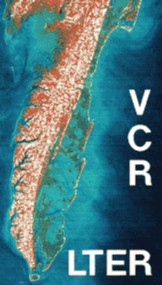 The Effects of Wrack Deposition and Increased Inundation Frequency on Production and Respiration in a Spartina patens/Distichlis spicata Salt Marsh |

Iris C. Anderson, W. David Miller, and Scott C. Neubauer
Virginia Institute of Marine Science
|
 The Effects of Wrack Deposition and Increased Inundation Frequency on Production and Respiration in a Spartina patens/Distichlis spicata Salt Marsh |

Iris C. Anderson, W. David Miller, and Scott C. Neubauer
Virginia Institute of Marine Science
|
Community Metabolism Measurements
Carbon dioxide exchanges were measured in the light and dark using (1) a temperature-controlled chamber (756 L) to measure total community production and respiration and (2) a sediment metabolism chamber (0.475 L) to measure microalgal production and microbial respiration. In order to scale up measurements of macrophyte productivity made over short time intervals, production (P) vs. irradiance (I) relationships were determined for each treatment and for each season. Based upon these P vs. I curves and using hourly values of irradiance from the LTER database, seasonal estimates of production were made.
In order to calculate annual sediment respiration it was necessary to determine the Q10 for each treatment. Q10 was based on the relationship between respiration and temperature using data collected over the entire 18 month study. Annual sediment respiration was then determined using the van't Hoff equation, the calculated Q10, and daily mean temperature values taken from the LTER database.
Pore Water Chemistry
Pore water lysimeters were installed within each treatment block and were sampled concurrently with carbon dioxide exchange studies. Lysimeters were purged by evacuation and then allowed to refill under vacuum for one hour. Salinity was determined using a refractometer. pH was
measured immediately following sampling. Samples for DIN were filter sterilized (0.2 µm Gelman supor filters) and kept cold until returned to the lab. Analyses were performed using an Alpkem "Flow Solution" autoanalyzer (Perstorp, 1992).
Sediment Characteristics
Sediment bulk density, % organic matter, and % water were determined for 0-2 and 2-10 cm sediment sections by standard techniques. Chlorophyll a was measured in the top 0-5 cm as described by Pinckney and Zingmark (1994).
| Sediment Characteristics | ||||
| Treatment | Bulk Density | % Organic Matter | ||
| 0-2 cm | 2 - 10 cm | 0 - 2 cm | 2 - 10 cm | |
| C.Bordered | 0.125(0.022) | 0.147(0.036) | 46 (4) | 45 (5) |
| Wrack | 0.146 (0.029) | 0.151(0.035) | 45 (8) | 47 (5) |
| Flooded | 0.107(0.022) | 0.139(0.027) | 48 (3) | 51 (3) |
| Seasonal Changes in pH and Salinity | ||||||
| Site | April | June | August | |||
| pH | Salinity | pH | Salinity | pH | Salinity | |
| Control | 6.59 | 9 | 6.53 | 12 | 6.56 | 15 |
| C-Bordered | 6.60 | 14 | 6.55 | 17 | 6.47 | 19 |
| Wrack | 6.81 | 16 | 6.64 | 16 | 6.69 | 18 |
| Flooded | 6.58 | 11 | 6.65 | 21 | 6.53 | 15 |
The relationship between sediment respiration and temperature for the control
site was used to calculate a Q10 for the control site as shown in Figure
2. Figure 2
Total net annual community production was similar for all treatments as shown in Figure 3.
Figure 3
Flooding did not appear to affect annual community respiration in the treated plots as shown in the Figure 4.
Figure 4
Most community respiration occurred during the summer season as shown in Figure 5.
Figure 5
Annual sediment respiration was impacted by the presence of a border which
reduced drainage, by flooding, and by wrack deposition as shown in Figure
6.
Figure 6
Conclusions
Based upon the preliminary results of this study we have drawn
the following conclusions:
€Increased inundation frequency did not significantly affect either macrophyte or microalgal productivity.
€Wrack deposition significantly decreased rates of both sediment and community respiration
€Use of a border around experimental plots significantly perturbed rates of sediment respiration.
€Preliminary estimates of gross macrophyte production by Spartina
patens and Distichlis spicata are in the range of estimates
made in other studies
Brinson, M. M., R. R. Christian, and L. K. Blum. 1995. Multiple states in the sea-level induced transition from terrestrial forest to estuary. Estuaries, 18 (4): 648-659.
Perstorp. 1992. Nitrate + Nitrite in Seawater. Perstorp Analytical Corporation.
Pinckney, J. L. and R. Zingmark. 1994. Comparison of high-performance liquid chromatographic, spectrophotometric, and fluorometric methods for determining chlorophyll a concentrations in estuarine sediments. Journal of Microbiological Methods. 19: 59-66.